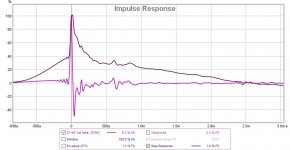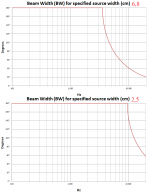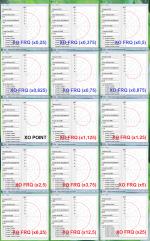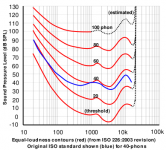Zoom in the time scale to first 20ms. You should see something that looks like a right triangle with tweeter at leading edge in phase with woofer. Your mic might be reverse polarity so it may be upside down - but you can click invert polarity in the IR response dialog box.
Something like this:
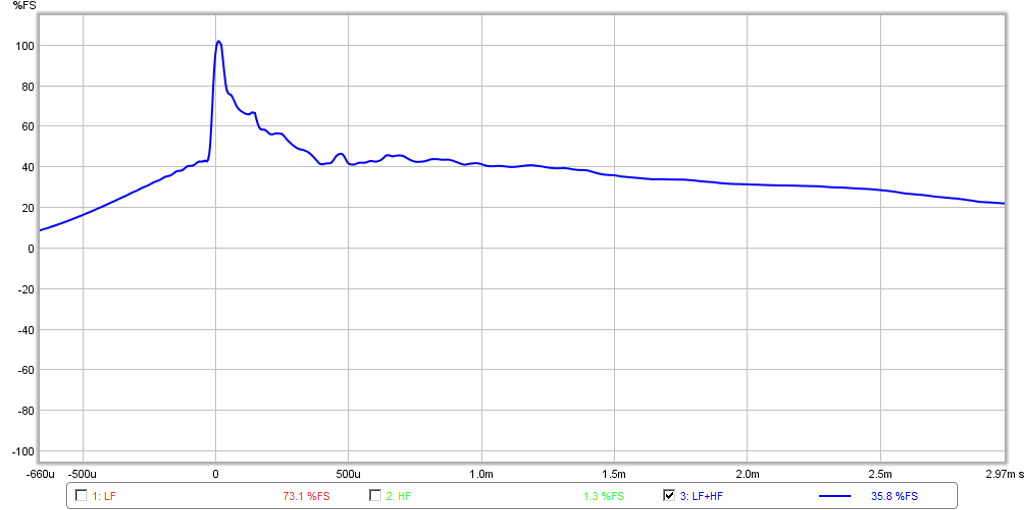
Something like this:

Ok, you got it - Harsch XO now confirmed positively. Congrats!

Now enjoy the music!
Alpha on top and FH9 on the bottom - most sound fantastic.

Now enjoy the music!
Alpha on top and FH9 on the bottom - most sound fantastic.
Haha 😀 Thanks man, i just followed what you guys did, Appreciate well documented process, and it took me only an hour from scratch 😀. i will post this at Harsch thread as well and YES ! it does sound fantastic of course !

Thanks again
A.

Thanks again
A.
Hi Astro,
Ok so what’s the longer term listening impressions verdict?
Looks like the SB23 worked out pretty well for a FAST in his case.
Ok so what’s the longer term listening impressions verdict?
Looks like the SB23 worked out pretty well for a FAST in his case.
Hi X.
It's fantastic ! everything is well balanced, the imaging, dynamics, very well separated instruments. you can defiantly hear the attack in some tracks, right now I m listening to "Dance Of The Aristocrats" by The Aristocrats, and the drum solo intro is very well reproduced, compare to my JBL 62, JBLs are defiantly brighter and still has more attack (maybe because of the tweeter ?) but is not as well balanced and neutral as these, specially vocals is way more natural, I wanted to record samples comparing JBLs to this but I do not have a good recording mic.
So far I can't stop listening, still here new stuff in different tracks.
Overall SB23 worked out very well, I don't need my subwoofer anymore.
I start looking into passive XO now 😀.
It's fantastic ! everything is well balanced, the imaging, dynamics, very well separated instruments. you can defiantly hear the attack in some tracks, right now I m listening to "Dance Of The Aristocrats" by The Aristocrats, and the drum solo intro is very well reproduced, compare to my JBL 62, JBLs are defiantly brighter and still has more attack (maybe because of the tweeter ?) but is not as well balanced and neutral as these, specially vocals is way more natural, I wanted to record samples comparing JBLs to this but I do not have a good recording mic.
So far I can't stop listening, still here new stuff in different tracks.
Overall SB23 worked out very well, I don't need my subwoofer anymore.
I start looking into passive XO now 😀.
Don't underestimate the power of that first octave in music. Get the subwoofer to integrate with the speakers just right, preferably in a similar time aligned fashion and it will be a very positive add-on. 😉
Great to hear that you enjoy them. No sub needed now? That’s impressive bass then. When you say JBL’s have more attack it may be that titanium dome tweeters have higher frequency range (they do) vs 3.5in fullrange driver, but what I meant about attack is the accuracy and snap of treble and bass combined. But it’s tough to beat this speaker for smoothness and clarity of vocals.
Don't underestimate the power of that first octave in music. Get the subwoofer to integrate with the speakers just right, preferably in a similar time aligned fashion and it will be a very positive add-on. 😉
yeah, true, i do not have a crossover for it tho 😀 but i will definitely set it up and running at some point.
Great to hear that you enjoy them. No sub needed now? That’s impressive bass then. When you say JBL’s have more attack it may be that titanium dome tweeters have higher frequency range (they do) vs 3.5in fullrange driver, but what I meant about attack is the accuracy and snap of treble and bass combined. But it’s tough to beat this speaker for smoothness and clarity of vocals.
I know what you mean, the right alignment of LF and HF will result in a snappy clicky signature, it is hard to explain, as you said this Harsch XO has a signature that you can hear on guitar strum or on drums ..., and you can hear it, with JBL it is not the brightness but the sharpness or "crisp attack" specially i noticed it on cymbals is lets say just a bit more obvious, not better or worse.
i will record some waves and try to compare it visually see if it s the tweeter deceiving me or else.
Last edited:
Sometimes, a basic HT style sub for $99 with built in plate amp and XO can sound quite nice. I tried one and it adds a lot “body” to the music. Not as good sounding as my bass horn sub but can sound very nice.
well don't get me wrong, i m definitely missing the low octave, i meant it's low enough that u may get away with it for most parts, i did built a sub while back all i need is a crossover.
anyhow back to JBL, i did some A/B and I was wrong the difference is not the "attack" or crispness, and it is not the tweeter, the test is ride/bell cymbal and freq range is around 400hz maybe up to 4K, maybe JBL has different FR in that range, but the FAST sounds more neutral, my DT880 pro sounds something in between.
what do you think ?
anyhow back to JBL, i did some A/B and I was wrong the difference is not the "attack" or crispness, and it is not the tweeter, the test is ride/bell cymbal and freq range is around 400hz maybe up to 4K, maybe JBL has different FR in that range, but the FAST sounds more neutral, my DT880 pro sounds something in between.
what do you think ?
Attachments
I listened to them on my car stereo through my phone’s Bluetooth. They definitely sound different. You might want a clip of varied music and not just a clip of cymbals trill. Maybe 45sec of 256kHz MP3 is about max. It sounds like the frequency response of JBL is “hot” around 2k-3k vs FAST which we know is flat there. It’s not the attack that I hear, but a definite frequency response anomaly on JBL. Maybe measure response of JBL and compare. I think it’s 3k or so.
...One thing tho, how do I get 12db Bessel slob in minidsp ? or is it only doable in HD version...
Sorry I'm late but ever since my post number 1112 didn't get any email notice from diyA server for this thread before today, and wow it is good to see you got it running and looking good 🙂.
About 2nd order Bessel target slope it can be reached in other ways, cascade one 2nd order LR slope with one PEQ +1,3dB Q=0,58, if in previous formal LR 2nd order slope is a problem then substitute it with two cascaded 1st order BW slopes because in practical LR slopes are always two cascaded BW slopes of half the order relative to targets order.
10F tips : )
Sounds like you did mixing and mastering work in the past which reminds me you should then know some serious trials down the road reaching a somehow final declining acoustic curve as frq goes up can probably enhance system so its closer to studio standards. Notice if you go nearfield listening with 10F and compare nearfield to another real tweeter system you won't notice 10F miss those 2-7kHz more extension compared to what a real tweeter system performs, which point to we shall be careful what we conclude out of this aspect, if you ask me the difference we sense out in room and listening position is power response problems in actual used XO-regions into room and also rooms natural brightness plus reverb and of course that 10F is a 68mm cone will make it start beam around 3,4kHz area. Many try with a lifted curve as frq goes up to get wide/full ranger driver to perform closer to what they sense a real tweeter performs, that's a alright tweak but try it out using a global linear phase EQ lift instead of a using minimum phase EQ lift or drivers natural minimum phase lift, reason is if for 10F up nearfield without any lift we get the correct minimum phase domain relation (amplitude verse phase) so harmonics line up as when mastered, now if we lift the global curve to repair for power response/beaming/room or whatever, we want original phase relation as mastered and therefor try use linear phase EQ to lift only amplitude so that phase stays same as up nearfield. My own 2-way 10F system is first dialed in to a minimum phase acoustic curve very close to F. Toole/JBL study of trained listener curve and then a low-Q linear phase EQ lift around 4kHz to repair HF power response for actual situation.
Below is pointers to expected power response errors, first is how 68mm verse 25mm driver beams, second is how HARSC within 1/4 wave center to center distance have some tilt and power response errors in area of 0,5 up to about 2,5 times the XO point frq.
Attachments
Last edited:
I listened to them on my car stereo through my phone’s Bluetooth. They definitely sound different. You might want a clip of varied music and not just a clip of cymbals trill. Maybe 45sec of 256kHz MP3 is about max. It sounds like the frequency response of JBL is “hot” around 2k-3k vs FAST which we know is flat there. It’s not the attack that I hear, but a definite frequency response anomaly on JBL. Maybe measure response of JBL and compare. I think it’s 3k or so.
Sorry I'm late but ever since my post number 1112 didn't get any email notice from diyA server for this thread before today, and wow it is good to see you got it running and looking good 🙂.
About 2nd order Bessel target slope it can be reached in other ways, cascade one 2nd order LR slope with one PEQ +1,3dB Q=0,58, if in previous formal LR 2nd order slope is a problem then substitute it with two cascaded 1st order BW slopes because in practical LR slopes are always two cascaded BW slopes of half the order relative to targets order.
10F tips : )
Sounds like you did mixing and mastering work in the past which reminds me you should then know some serious trials down the road reaching a somehow final declining acoustic curve as frq goes up can probably enhance system so its closer to studio standards. Notice if you go nearfield listening with 10F and compare nearfield to another real tweeter system you won't notice 10F miss those 2-7kHz more extension compared to what a real tweeter system performs, which point to we shall be careful what we conclude out of this aspect, if you ask me the difference we sense out in room and listening position is power response problems in actual used XO-regions into room and also rooms natural brightness plus reverb and of course that 10F is a 68mm cone will make it start beam around 3,4kHz area. Many try with a lifted curve as frq goes up to get wide/full ranger driver to perform closer to what they sense a real tweeter performs, that's a alright tweak but try it out using a global linear phase EQ lift instead of a using minimum phase EQ lift or drivers natural minimum phase lift, reason is if for 10F up nearfield without any lift we get the correct minimum phase domain relation (amplitude verse phase) so harmonics line up as when mastered, now if we lift the global curve to repair for power response/beaming/room or whatever, we want original phase relation as mastered and therefor try use linear phase EQ to lift only amplitude so that phase stays same as up nearfield. My own 2-way 10F system is first dialed in to a minimum phase acoustic curve very close to F. Toole/JBL study of trained listener curve and then a low-Q linear phase EQ lift around 4kHz to repair HF power response for actual situation.
Below is pointers to expected power response errors, first is how 68mm verse 25mm driver beams, second is how HARSC within 1/4 wave center to center distance have some tilt and power response errors in area of 0,5 up to about 2,5 times the XO point frq.
sorry GF was here over the weekend couldn't do any tweaking, but you are right, 10F is missing some highs in listening spot, having a high shelf will probably help, i will try that and will post the results, also will try to get some FR from JBLs, but have no idea how to use a linear phase eq here, it would be nice if there was a way to run VSTs on windows output. Foobar maybe an option here, what do you think ?
Last edited:
it would be nice if there was a way to run VSTs on windows output. Foobar maybe an option here, what do you think ?
You could use JRiver. They have a driver that takes over Windows output and routes it through JRiver, where you can add EQ, convolution, and your own VSTs.
There is a 30-day demo that you can try, so it's worth checking it out.
You could use JRiver. They have a driver that takes over Windows output and routes it through JRiver, where you can add EQ, convolution, and your own VSTs.
There is a 30-day demo that you can try, so it's worth checking it out.
cool, thanks, gonna give it a try 🙂
FAST SEALED build from other side of the world.Thanks to XRK for the enthusiasm ,awesome guidance and sourcing. I only had to fix everything together. The build uses ply and needs a better enclosure to extract maximum benefit from the drivers. The orange dagger cone as shown in some of the FAST posts was used.Acoustic parts express foam used in the bottom plane and back plane . I cut some the same foam and stuffed it into the dagger cone also. Its early days as the spkr is up only a few hours of play.The bass at low volumes driven from a nad316bee was revealing . Need to hook up other DIY amps like quasi,elvee this week.
Attachments
cool, thanks, gonna give it a try 🙂
If JRiver is new territory to you throw a PM for quick guide help setup the important first steps to get bit perfect audio stream and create/load a linear phase filter, also if you find it good (suggest use 64bit version if OS support it) can help setup feature of R128 algorithm tracks leveling and if soundcard is 24bit or more then dynamic feature "Equal loudness ISO 226-2003" is so fantastic a experience when dialed in.
Attachments
FAST SEALED build from other side of the world.Thanks to XRK for the enthusiasm ,awesome guidance and sourcing. I only had to fix everything together. The build uses ply and needs a better enclosure to extract maximum benefit from the drivers. The orange dagger cone as shown in some of the FAST posts was used.Acoustic parts express foam used in the bottom plane and back plane . I cut some the same foam and stuffed it into the dagger cone also. Its early days as the spkr is up only a few hours of play.The bass at low volumes driven from a nad316bee was revealing . Need to hook up other DIY amps like quasi,elvee this week.
Congratulations, Nareshn!

Happy to help and glad that it is working out. You might want to add some fiberglass fill into the cone. Fiberglass inside main box in addition to foam lined walls is good too as it increases apparent volume and lowers fb.
Btw, your uploaded photos are tiny.
If JRiver is new territory to you throw a PM for quick guide help setup the important first steps to get bit perfect audio stream and create/load a linear phase filter, also if you find it good (suggest use 64bit version if OS support it) can help setup feature of R128 algorithm tracks leveling and if soundcard is 24bit or more then dynamic feature "Equal loudness ISO 226-2003" is so fantastic a experience when dialed in.
Hello Byrtt,
Did you share that guide on DIYAudio already? If yes, where? so I can look it up.
I'd be interested to see if my setup is at its best, or if there is something I could do better!
- Home
- Loudspeakers
- Full Range
- 10F/8424 & RS225-8 FAST / WAW Ref Monitor
